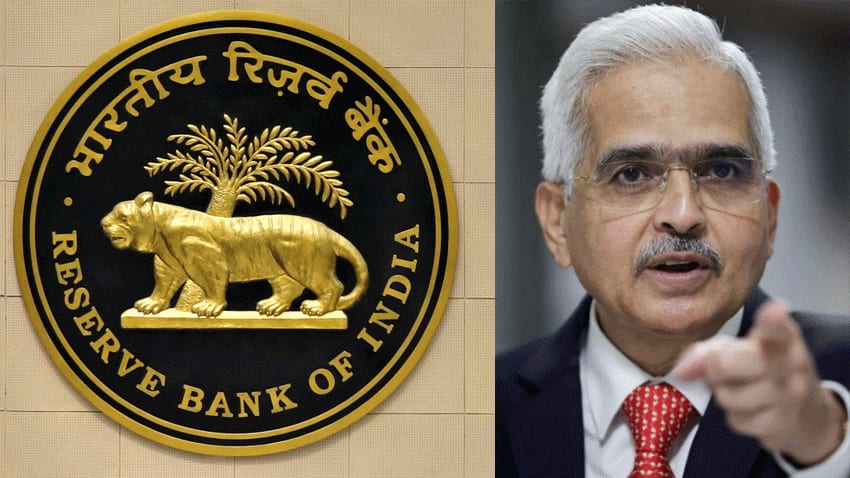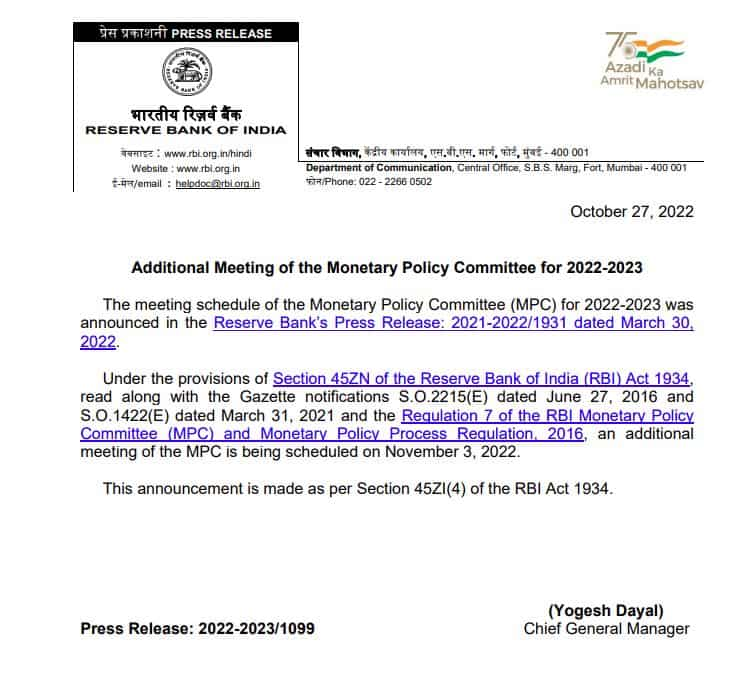Next RBI MPC Meeting 2022: 1st time ever Reserve Bank is doing this - Monetary Policy Review, Rate Hike? All you need to know
Monetary Policy Committee (MPC) Meeting: The Reserve Bank will submit a report to the government on its failure to keep the retail inflation rate below six per cent for three consecutive quarters beginning January 2022.

This is happening for the first time since the implementation of the monetary policy framework in 2016. Reserve Bank of India (RBI) has called a special meeting of the Monetary Policy Committee (MPC) on November 3, to prepare its report on missing inflation targets to the government.
The six-member rate-setting panel is headed by RBI Governor Shaktikanta Das.
The Reserve Bank will submit a report to the government on its failure to keep the retail inflation rate below six per cent for three consecutive quarters beginning January 2022.
Monetary Policy Committee (MPC)
The monetary policy framework, which came into effect about six years ago, mandates the Reserve Bank of India (RBI) to maintain retail inflation at 4 per cent with a margin of 2 per cent on either side.
In case of failure to maintain the inflation target for three consecutive quarters, the central bank, under section 45ZN of the RBI Act, is required to submit a report to the government explaining the reasons and spelling out the remedial actions it would be taking to check the price rise.
"Under the provisions of Section 45ZN of the Reserve Bank of India (RBI) Act... An additional meeting of the MPC is being scheduled on November 3, 2022," the central bank said in a statement.
Section 45ZN of the Act deals with failure to maintain the inflation target.
Governor Das had earlier said the central bank will not make the report public. It is not clear if the government too would like to keep the report confidential or make it public for wider discussions and deliberations, he had said.
To tackle price rise, the government in 2016 gave a mandate to the RBI to keep retail inflation at 4 per cent with a margin of 2 per cent on either side for a five-year period ending March 31, 2021.
Section 45-ZA of the RBI Act, 1934
Section 45-ZA of the RBI Act, 1934 requires that the central government shall, in consultation with the RBI, determine the inflation target in terms of Consumer Price Index (CPI), once in every five years.
As per a notification issued on March 31, 2021, the central government retained the inflation target at 4 per cent (with the upper tolerance level of 6 per cent and the lower tolerance level of 2 per cent) for the 5-year period April 1, 2021 to March 31, 2026.
The MPC held its first meeting in October 2016 and the last meeting, held during September 28-30, 2022, was the 38th meeting of the rate-setting panel.
The retail inflation based on CPI has remained above 6 per cent since January 2022. It was 7.41 per cent in September. The MPC factors in retail inflation while deciding the bi-monthly monetary policy.
If the average inflation remains above the upper tolerance level or less than the lower tolerance level for any three consecutive quarters, it will be considered a failure on part of the RBI in meeting the inflation-targetting mandate.
The RBI has been aggressively raising the key interest rate since May in a bid to contain inflation. It has so far raised the short-term lending rate by 190 basis points, taking the repo rate to a nearly three-year high of 5.9 per cent.
RBI retained inflation projection for 2022-23 at 6.7 per cent
-Last month, the RBI retained its inflation projection for 2022-23 at 6.7 per cent amid geopolitical concerns triggered by the Russia-Ukraine war, and expected inflation to be under control from January.
-It may be noted that inflation had overshot the target for over three quarters during the coronavirus pandemic period as well.
-But a technical shortcoming in the data collection, wherein data was collected without visiting the mandis because of the pandemic related, had helped ensure that no such explanation had to be given by the RBI at that time.
SBI Ecowrap - Of central banks and rate hikes, the perception and the impending reality: RBI Nov 3 meeting purely to address the shortfall in meeting the inflation target for 3 successive quarters
According to SBI Ecowrap report, authored by Dr. Soumya Kanti Ghosh, Group Chief Economic Adviser, State Bank of India, RBI Nov 3 meeting is purely to address the shortfall in meeting the inflation target for 3 successive quarters.
"The current unscheduled meeting on 3 Nov’22 under Section 45ZN of the RBI Act is only a part of the regulatory obligation and we do not foresee any other agenda to be announced at this meeting, even as it is scheduled a day after the Fed meet on 2nd Nov’22. Furthermore, looking at the past unscheduled meetings of MPC in Mar’20 and May’22, there were no press release of such meetings earlier and the announcement of rate decision was unscheduled in true sense. RBI in its Report on Currency & Finance (2020-21) has mentioned that in the case of India, failure may be redefined as inflation overshooting/ undershooting the upper or lower tolerance bands around the target for four consecutive quarters instead of current three quarters," as per SBI Ecowrap report.
"Meanwhile, global data contradictions are galore. US GDP growth came in stronger than expectations (on the back of a stronger oil exports), even as DXY has weakened against the market perception of a slower than anticipated rate hike by Fed post November. A dovish ECB guidance, coupled with a dovish Bank of Canada rate hike confirms that such optimism of the markets may not be entirely unfounded," the report added.
"The most recent reading of the US Employment Cost Index showed a considerable slowdown in private-sector wage growth in the third quarter - it rose 1.2% compared to 1.6% in the second quarter indicating that the wage-price spiral is beginning to ease. Consumer spending, which accounts for more than two-thirds of US economic activity, showed growth slowing to a 1.4% rate from the second quarter's 2.0%. New orders for non-defence capital goods, viewed as a proxy for business spending, fell unexpectedly in September. All this conjures up for a significantly lower probability of 75 bps hike for mid-December (65% probability), with the narrative for a 50 bps hike taking pole position now," the report further added.
"Against this background, recent MPC minutes in India suggest some members looking for an early end to the rate hike cycle. The unseasonal rains in several parts of the country (in food grains producing states also) in October this year are affecting kharif crops significantly. In states like UP, the unseasonal rain was more than 400% above than the normal. In 2019, when unseasonal rains happened, average food prices more than doubled from 4.9% to 10.9% . Currently, the September food inflation is at 8.4% and a similar trend like the one seen in 2019 can put headline inflation towards 7.5% in December. This could put a spanner to the inflation projections of RBI and market consensus. This could also mean that the terminal repo rate could still be difficult to comprehend at this time, though consensus puts it at 6.5%,"
"Nevertheless, liquidity deficit in the banking system has been now consistently running at Rs 60,000 crore for the last 4 days. Banks have adjusted deposit rates significantly upwards in October. If we look at the historical interest rate cycles, the increase in deposit rates lag the increase in lending rates. Also, given that 45% of bank deposits are CASA, it is only the 55% of term deposits that need adjustment and hence ideally, there will always be less than full adjustment of deposit rates to repo rates. In the current cycle, with a CASA ratio of 45%, a 190 basis point increase in repo rate could result in 105 basis point increase in deposit rate (190*55%). Any deposit rate increase beyond that will be an additional one. To put things in perspective, SBI has already raised its 1 year deposit rate by 100 basis points," as per the report.
"The good news is that INR has continued its comparative resilience, strengthening on the back of recent fall in Dollar index. Even though the current Dollar descend could be a temporary phenomenon as markets love to side with somewhat illusory narratives before policy meets that inflation has peaked due to policy actions, the wild swings seen post select tech behemoths’ results point to markets pricing in more the weaker forward guidance over the better than expected immediate results. Also, on ECB front, during the first five months in FY23, total ECB raised by corporates is a paltry $8.26 bn (against $11.23 bn in first five months during FY22 and $39.89 bn during the full year). If better rated Corporates raise fresh ECB now, that should help the RBI in also doing Buy/Sell swaps, bringing down hedging cost while lowering the Forward Premia too! This will mean an improvement in capital flows that could have a positive bearing on exchange rate outlook," the SBI report concluded.
Get Latest Business News, Stock Market Updates and Videos; Check your tax outgo through Income Tax Calculator and save money through our Personal Finance coverage. Check Business Breaking News Live on Zee Business Twitter and Facebook. Subscribe on YouTube.
RECOMMENDED STORIES

Rs 3,500 Monthly SIP for 35 years vs Rs 35,000 Monthly SIP for 16 Years: Which can give you higher corpus in long term? See calculations

Power of Compounding: How long it will take to build Rs 5 crore corpus with Rs 5,000, Rs 10,000 and Rs 15,000 monthly investments?

Looking for short term investment ideas? Analysts suggest buying these 2 stocks for potential gain; check targets

SCSS vs FD: Which guaranteed return scheme will give you more quarterly income on Rs 20,00,000 investment?

Small SIP, Big Impact: Rs 1,111 monthly SIP for 40 years, Rs 11,111 for 20 years or Rs 22,222 for 10 years, which do you think works best?
07:13 PM IST










 RBI: After another status quo year, all eyes on a growth-propping rate cut with new Guv at helm By Ashish Agashe
RBI: After another status quo year, all eyes on a growth-propping rate cut with new Guv at helm By Ashish Agashe Electricity distribution companies continue to remain a burden on state finances: RBI
Electricity distribution companies continue to remain a burden on state finances: RBI RBI imposes penalties on IndusInd Bank and Manappuram Finance for non-compliance of certain norms
RBI imposes penalties on IndusInd Bank and Manappuram Finance for non-compliance of certain norms Forex reserves drop $2 billion to $652.86 billion
Forex reserves drop $2 billion to $652.86 billion RBI flags rising subsidies by states as incipient stress
RBI flags rising subsidies by states as incipient stress